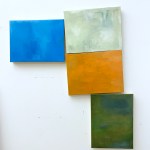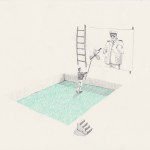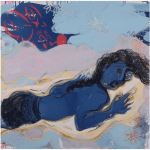Guest Contributor Joshua Sevits / The Hall Art Foundation in bucolic Reading, Vermont, is located in a faithfully restored stone farmhouse with three large barns, each of which has been turned into exhibition space. The barns now incongruously house a retrospective of Peter Saul’s Day-Glo paintings of giant combustive genitalia, serpentine poop, and uncompromisingly violent characterizations of western civilization. This attentively organized exhibition spans fifty-three years and
comprises thirty-seven works–ranging from meticulously nuanced compositions to crude political caricatures–that vividly reflect many of the painting
sensibilities that prevail today.
[Image at top: Peter Saul, Yankee Garbage 1966, acrylic, felt tip pen, canvas, 71.75 x 69.75 inches, courtesy Hall Art Foundation, � Peter Saul]
At his best, Saul is a bitterly sardonic painter who applies precise craft and the jaw-dropping use of color to intuitively arranged compositions. Above all, Saul is a driven storyteller whose work is never boring. A sense of frustration permeates Saul�s early paintings from the late fifties through the mid-sixties. These pieces were made before Saul discovered acrylic mediums and before he began addressing political and social issues–the American war machine, the systematic brutalization of women, victimization of minorities, the plight of poor and indigenous peoples, and the overall shallowness of everyday life. The small oil paintings reveal him as a young artist beginning just after the tumult of Abstract Expressionism. But while the works on paper may owe their seemingly haphazard mark-making to Gorky and de Kooning, Saul also developed a penchant for surreal representational and figurative imagery, often interjecting, in line with Pop Art innovations, something commercial or industrial: a hat, a cigarette, a glove, a submarine. This practice helped ground his work in the provocative social critique that distinguished the Chicago Imagist group with which he is closely associated.
Ice Box 8 (1963)–a large oil painting depicting a young person with a soda bottle for a torso and head, racing toward an open refrigerator–exemplifies Saul’s attachment to both social critique and audacious paint application. The red zig-zag line, here connecting the running figure and the food inside the fridge, is a gesture and compositional structure that appears in many of his pictures. It playfully amplifies the American desire to be satiated by commodity goods, as Guston did in a very different way with his inert, cartoon-like paintings. But Saul also exposes the viewer to more destabilizing elements: a revolver and a book are nestled between ham and condiments. The flowing experimentation and imagination in these early works bring to mind a number of eclectic contemporary painters, including Nicole Eisenmen, Jennifer Coates, Jamnian Juliano-Villani, and Joshua Abelow.
Custer�s Last Stand II (1974), one of two masterpieces in the show, reflects Saul�s signature binary opposition between content and image. Much as Tarantino�s Inglourious Basterds gives the audience the visceral satisfaction of witnessing Hitler’s death by countless rounds to the face, Saul treats the viewer to a dopey Tex Avery-style Custer as he is scalped, his skull peeling like a piece of fruit to reveal his juicy red brain while idiosyncratically goofy Native Americans with potbellies and big noses–one with a pretty headdress of pink, orange, red, and yellow–circle U.S. cavalrymen and kill them in their own special ways. The other standout is Subway I (1979), featuring a half-obliterated subway car as a site of urban warfare between mainly white cops and non-white civilians, which of course remains poignant today.
Saul relies on the meat and potatoes of color theory, deploying a quadratic color combination that establishes instant visual harmony and also allows for copious–and sometimes confounding–detail. The viewer’s eye scans from one gruesome mess to another, the red-orange blood functioning like an elastic band holding the fight together. Each ripple of flesh and drop of blood has its own light source, so the totality of the scene, and the number of individuals involved, takes time to apprehend. In any case, he keeps you looking.
A guided tour is required at the Hall Art Foundation. It was amusing to hear the docent describe the double-headed poop labeled “upper class, lower class” in the painting of the same name, and interesting to learn that Saul was disappointed with the lack of press he received, good or bad, during his years as an emerging and mid-career artist. This may have been due to his unique relationship with his late dealer Allan Frumkin, who would pay Saul for work and then decide whether or not to show it. Roberta Smith puts this old-fashioned artist/dealer relationship into focus in her review of Saul�s spring show From Pop to Punk at Venus Over Manhattan. Because so much of his work is in private hands, the exhibition at the Hall Art Foundation provides a rare chance to see a wide swathe of Saul’s muscular oeuvre.
“Peter Saul” Hall Art Foundation, Reading, Vermont. Through November 29, 2015.
——
Two Coats of Paint is licensed under a Creative Commons Attribution – Noncommercial-No Derivative Works 3.0 United States License. To use content beyond the scope of this license, permission is required.




















great stuff.
I'd kill for that untitled pastel from 1960.
He's a wonderful artist.